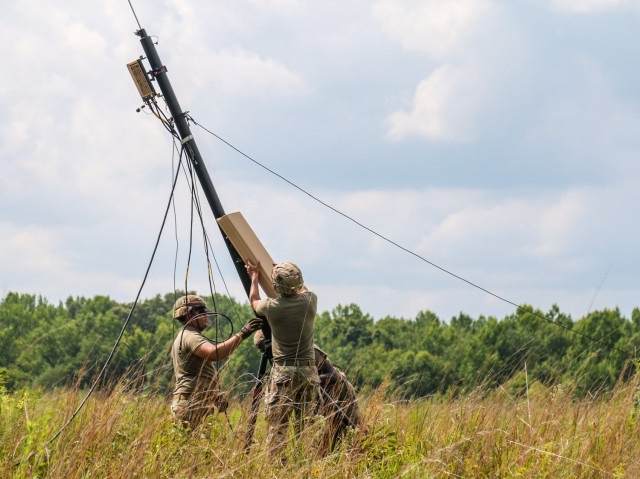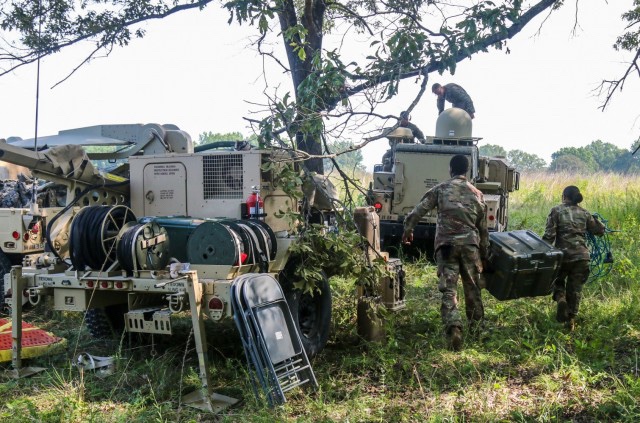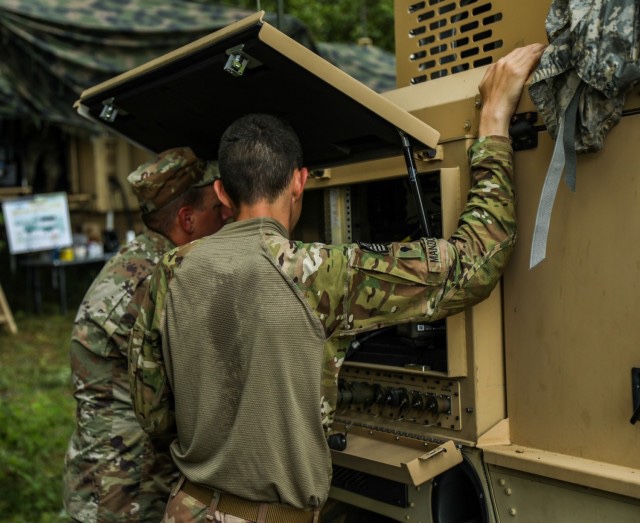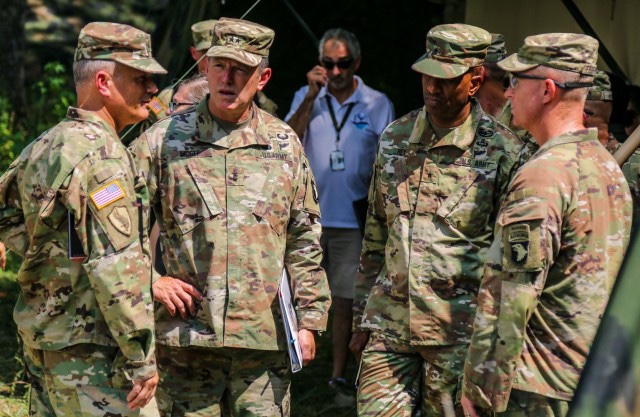
FORT CAMPBELL, Ky. — Soldiers from Headquarters and Headquarters Company, 3rd Brigade Combat Team, 101st Airborne Division (Air Assault), conducted a Command Post Modernization Operational Assessment July 22-26, at the Kinnard Mission Training Complex on post.
Command Post Integrated Infrastructure, better known as CPI2, is a major modernization line of effort. It integrates emerging technologies and capabilities with mobile mission command platforms and command post support vehicles as a means of increasing agility and improving survivability on the battlefield.
“CIP2 will help units succeed in combat by providing mobility of the command post and getting after the signature aspects, like the electromagnetic and physical signature by reducing the number of vehicles and providing the workspace for units to be successful in their mission set,” said Lt. Col. Jeremy Rogers, product manager for CPI2.

The previous program that CPI2 is attempting to replace typically took between four and eight hours to set up and displace, says Rogers. The goal is to reduce this time down to approximately 30 minutes.
Utilizing this program has knocked placement and displacement times down to between an hour and an hour and a half, approximately 80% faster than before. This is done by reducing the footprint that the tactical command post, or TOC, normally creates.
“The TOC tents that we were used to in the past were a large footprint,” said Staff Sergeant Michael Prater, an operations and plans Noncommissioned officer for 3 BCT and battle NCO for the operation. “This is a more mobile, smaller, diverse footprint that creates a better way of getting into the fight and getting out of the fight.”

Prater’s focus, as the operational NCO, has been teaching the Soldiers, officers and other NCOs of his unit how to use, set up and tear down the equipment, focusing on increasing efficiency over time.
Being more mobile enables Soldiers to move, shoot and communicate with the efficiency they need to accomplish the mission. So far, other units that have tested this innovative system include, 2nd Stryker BCT, 2nd Infantry Division; and Headquarters, 4th Infantry Division, each with different command post configurations.
“As we take the unit feedback from both of our operational assessments, it will help inform not only our future requirements, but the baseline of the command post moving forward,” said Rogers.

Spc. Lance Lee, brigade air defense valve management systems operator for HHC, 3 BCT, says that CPI2 makes his life a lot easier because he is able to fall in on a pre-made shelter with network connectivity ports already allotted to him, eliminating time previously spent searching for a spot on the switch.
“CPI2 is a valuable asset for us because we’re able to fall in on an experimental software location where we can try new ideas, and essentially game plan to create new ways for us to affect the fight for the brigade commander,” said Lee. “I serve in the Army to make a difference, to innovate, and to get out there and try to find a new solution to currently existing problems. If I can be at the forefront of finding something that can affect the fight for the future, then I will be.”
By SPC Andrea Notter, 40th Public Affairs Detachment


Nagorno-Karabach showed just how out dated the use of tent based command posts was in the age of suicide drones, hyper fast kill chains and integrated ISR. Anything we can do to make command posts and aid stations more mobile and survivable is a solid win. We need a hell of a lot more than this one exercise though.
Exactly, also huge RF hotspots. These days you might as well just have a concert since it will draw nearly as much attention from a near peer or peer competitor(we all know who we are talking about here).
What a waste. A BN CP can be set up and run out of an LMTV. All that’s required is the Army to prohibit the use of massive TOC tent set ups. The alternative is to watch them all die in a conventional war. The footprint in IR, and EM is huge just so someone can walk in and play Patton.
You ever run a Division Main CP? During the Cold War in Germany, we would move CPs every few hours. Everything was in expandavans.
I never worked inside it, but I remember seeing the 1AD Division Main CP, circa 1989, out in the German countryside. Yes, it had most functions inside 5-ton expando-vans. It also had a huge forest of antennas, and the whole shebang was under an absolutely massive collection of camo netting. No way on Earth they moved that circus in less than a day, unless they abandoned a shitload and just bugged out with essential vehicles only. Call it 2 hours (?), to collapse interiors, hitch generators to prime-movers, and try to move out of a muddy field, in the dark, to a paved road.
There was also a DIV FWD, a DIV Rear, and I think also a RAOC (Rear Area Operations Center), if I recall correctly. There was some overlap of function, of course.
One of the insane idiosyncrasies of 1AD at that time and place was a fetishization of camouflage netting. When set up inside buildings in the cantonment areas at Graf or Hohenfels, it was mandatory to string up camo netting INSIDE the buildings, to divide up the open bays into little offices and workspaces, etc. Total leg-mentality dog-and-pony bullshit, from some fevered mind, but that was peacetime SOP.
It wasn’t until the next year when we deployed to Desert Shield/Storm that things were streamlined for fast-paced mechanized war. By necessity for the upcoming mechanized attack, up and down the chain, CP’s and S-3 shops were whittled to an officer and an NCO in the back of a moving HMMWV or track, with a big board, grease pencils, and a bunch of radios. I understand that our Division CG, MG Fred Franks, alternated between a small mobile CP and a UH-60. In the Blackhawk, he had a sheet of plywood with a situation map mounted on the aft bulkhead, his Current Ops officer, and a couple other key staff running radios and trying to manually update the map .
AbnMedOps,
The CP for any unit serves two functions. One is to help the Commander make timely and sound decisions – the Art of War. Two is to coordinate, direct, synchronize, and deconflict, all the myriad of details necessary to keep the organization itself functioning and on mission – the Science of War.
In practice, the Commander doesn’t need a big footprint to do his job effectively. Frankly, for command survivability, it i best for the Commander to stay away from the CP. Unfortunately, even with advanced communications systems, the complexities of modern warfare have tended to make the CPs bigger and bigger. Both in size and in signature.
I suspect that for Brigade HQs and above the answer will be some kind of not-yet-invented “distributed” CP model that habitually disperses the physical components while maintaining the necessary connectivity of function. Something like a new – and hopefully more successful – Pentomic Division concept.
TLB
You might be able to run something out of an LMTV in the assault, but for sustained operations, supporting 20-100 positions, it’s not feasible to run it out of a vehicle.
IT’s not very feasible to have a massive CP footprint under persistent IDF or aerial fires. We expect all these MC systems to run perfectly under cyber and EW attacks, and demand a level of information that’s not achievable. Commander’s expect a GWOT-level of resources that will frankly not happen.
One of the biggest JRTC takeways remains Unit Commander’s have too close of a hold on IDF assets. There are BDE commander’s requiring clearance before even mortar employment, which does not happen in a timely manner.
The Army needs to learn the lesson instead of just saying “wow we did great moving along” at JRTC/NTC/XCTC.
We could look historically to such lessons as Kasserine Pass….
Park two MTVs next to each other facing opposite directions.
Roll up the canvas on the adjacent sides.
Install some wooden tables/counters inside on the adjacent sides.
Boom, mobile TOC that can support 10-15 workstations, facilitate face to face crosstalk between MTVs, can tow its own electrical and A/C generator, and bring its own crew served weapon for position defense, and can pull up stakes and depart the area in under a minute.
Park two MTVs next to each other facing opposite directions.
Roll up the canvas on the adjacent sides.
Install some wooden tables/counters inside on the adjacent sides.
Add a QEAM or some extra antenna mounts.
Boom, mobile TOC that can support 10-15 workstations, facilitate face to face crosstalk between MTVs, can tow its own electrical and A/C generator, bring its own cab-mounted crew served weapon for position defense, and can pull up stakes and depart the area in under a minute. Maybe longer if you need to strike a bunch of antennas, or choose to unhitch the generator and drop it a dozen meters away for noise mitigation.